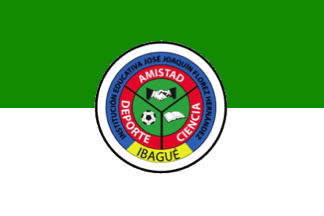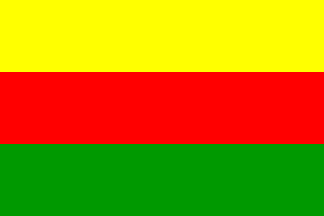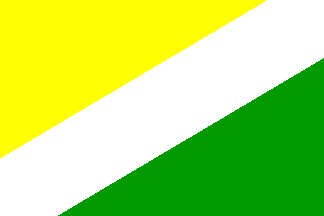 klaus-michael schneider
klaus-michael schneider
Keywords: education |
Links: FOTW homepage | search | disclaimer and copyright | write us | mirrors

FOTW beschäftigt sich mit der Wissenschaft der Vexillologie (Flaggenkunde).
Alle auf dieser Website dargebotenen Abbildungen dienen ausschließlich der Informationsvermittlung im Sinne der Flaggenkunde.
Wir distanziert uns ausdrücklich von allen hierauf dargestellten Symbolen verfassungsfeindlicher Organisationen.
Last modified: 2021-05-22 by  klaus-michael schneider
klaus-michael schneider
Keywords: education |
Links: FOTW homepage |
search |
disclaimer and copyright |
write us |
mirrors
![[Flag of Colombia]](../images/c/co.gif) (2:3)
(2:3)  image by Željko Heimer, 20 May 2001
image by Željko Heimer, 20 May 2001
See also:
 image by Ivan Sache, 13 May 2021
image by Ivan Sache, 13 May 2021
Institución Educativa José Joaquín Flórez Hernández, located
in Ibagué (Tolima), is named for José Joaquín Flórez Hernández (1919-1996),
Bishop of Duitama-Sogamoso (1955-1964), Bishop (1964-1974) then Archbishop (1974-1993) of Ibagué.
The flag of IE José Joaquín Flórez Hernándezz is horizontally divided
green-white with the school's emblem in the center.
Source:school symbols page
Ivan Sache, 13 May 2021
 image by Ivan Sache, 10 January 2021
image by Ivan Sache, 10 January 2021
INEM José Manuel Rodríguez Torices was established in Cartagena (Bolívar) by
Decree No. 1963 issued in 1969 and amended by Decree No. 1,085 issued on 8 June
1971. Classes started on 1 March 1971.
The school is named for Cartagena-born
José Manuel Rodríguez Torices (1788-1816). One of the signatories of the
declaration of independence of the State of Cartagena on 11 November 1811, he
was elected President in 1812 and President of the United Provinces of New
Granada from 28 July to 17 August 1815. In the aftermath of the Spanish
reconquest, he was captured in Popayán and executed in Bogotá.
The flag of INEM José Manuel Rodríguez Torices is horizontally divided white-green.
Source:school website
Ivan Sache, 10 January 2021
 image by Ivan Sache, 13 January 2009
image by Ivan Sache, 13 January 2009
"Colegio Nacional 'José Maria Córdoba'" was
founded in 1946 in Montería, Department of Córdoba, as
"Colegio de Segunda Enseñenza", and renamed in 1953
"Colegio Nacional 'José Maria Córdoba'" (CONALCO). In
1962, the institute housed the emerging "Universidad
Nacional de Córdoba".
The institute is named after General José Maria Córdova
(1799-1829), a hero of the Wars of Independence against Spain.
The Department of Córdoba was also named after him.
The flag of the institute, as shown and described on the website of the
institute, is horizontally divided yellow-red-green.
The colours are inspired by the "national symbology".
Yellow represents the Colombian people, red the blood shed in the
struggle for sovereignty, and green the aspiration to liberty.
The colours also represent the profile of the educationalist
collectivity. Yellow represents light, dynamism and a center of
resource and cultural material. Red means distinction and joy of
life in an atmosphere of affect and vital reason. Green
represents the natural environment.
Ivan Sache, 13 January 2009
 image by Ivan Sache, 14 December 2014
image by Ivan Sache, 14 December 2014
Institución Educativa Técnica Industrial José Maria Córdoba was
established in El Santuario (Antioquia Department) by State Law No. 80
of 29 November 1962, promulgated on 19 December 1962, as Escuela de
Artes y Oficios. Merged by Decree with Liceo San Luis Gonzaga in 1969,
the institute recovered its autonomy in 1971 on a juridical basis: the
Decree that had invalidated the original State Law was declared null
and void (because a Law can be invalidated only by another Law, not by
a Decree). The school was renamed Instituto Técnico Industrial
Nacional (ITIN) in 1978. In 1979, President of the Republic Julio
César Turbay Ayala (1978-1982), when visiting the town for the
commemoration of the 150 years of death of General José María Córdoba
(1799-1829), decided to rename the institute for the general, a hero
of the Wars of Independence against Spain - also the namesake of
Córdoba Department.
Institución Educativa Técnica Industrial José Maria Córdoba was
eventually established by Departmental Resolution No. 696 of 4
February 2003 as the merger of ITIN and Escuela Eusebio María Gómez.
The flag of the institute is horizontally divided green-white with the
institute's emblem in the middle.
The emblem, designed in 1974 by the student Rodrigo Vargas Ramírez, is
made of a disk divided green-white according to the ascending
diagonal, charged with a pair of compasses and, in base, a flaming
torch, and framed by a golden yellow cogwheel inscribed with the
institute's name and place.
Source:
http://itinelsantuario.edu.co/index.php?option=com_content&view=article&id=5&Itemid=5 - Institute's website
Photo:
http://itinelsantuario.edu.co/images/phocagallery/institucional/thumbs/phoca_thumb_l_dsc_0402.jpg
Ivan Sache, 14 December 2014
 image by Ivan Sache, 21 November 2014
image by Ivan Sache, 21 November 2014
Institución Educativa José María Potier dates back to 1924, when His Grace
José María Potier, Apostolic Prefect of Arauca, invited the Christian Brother (Lasallians)
to Chita (Boyacá Department). They founded Liceo de San Luís Gonzaga and managed
it for the next 12 years. The Prefect then founded in 1944 Liceo Pio XII, which
was renamed Seminario Misional de la Virgen Milagrosa in 1950. Colegio Seminario
José María Potier was established in 1969 as the merger of Seminario La
Milagrosa and Colegio José María Potier. Institución Educativa Técnica y
Académica José María Potier was established by Resolution No. 2,457 of 6 October
2003 as the merger of Instituto Técnico Agropecuario José María Potier and
Colegio Seminario Misional La Milagrosa. The name of the institute was
eventually shortened to Institución Educativa José María Potier by Resolution
No. 3,173 of 15 December 2008.
The flag of the institute is diagonally divided yellow-white-green according to
the ascending diagonal. Yellow is a universal symbol of wealth. It recalls the
ecclesiastic roots of the institute, once a seminary. It is also a symbol of
energy, light and enlightenment. White is a symbol of purity, and especially, of
transparency and honesty. Green is a symbol of hope, love for the natural
environment and the compromise required to preserve the natural resources.
Source:
http://colpotierchita.jimdo.com/simbolos-institucionales/ - Institute's
website
Ivan Sache, 21 November 2014
 image by Ivan Sache, 28 November 2014
image by Ivan Sache, 28 November 2014
Institución Educativa Técnico Comercial José María Vivas Balcázar is
located in Cali (Valle Department).
The institute is named for the poet, writer and educationalist José
María Vivas Balcázar (1918-1960), Secretary of the Colombian National
Broadcasting Corporation and editor of the review "Las Indias" (see
http://victorlopezerazo.blogspot.fr/2009/08/jose-maria-vivas-balcazar.html for a biography and poems).
The flag of the institute, in dimensions 1.50 m x 2.70 m [5:9], is
horizontally divided red-gray-green.
Red means energy, charity and love. It is a symbol of power, victory,
audacity and highness. It is the colour of beautiful flowers, of fire
and blood.
Gray is a symbol of rectitude, clearness, elation, glory and sanity.
Green denotes faith, service, respect, youth and, most of all, hope.
Source: http://ievivasbalcazarcali.amawebs.com/ - Institute's website
Ivan Sache, 28 November 2014
 image by Ivan Sache, 10 January 2021
image by Ivan Sache, 10 January 2021
IE José Miguel de la Calle, located in Envigado (Antioquia), is named for
Envigado-born priest José Miguel de la Calle (1755-1839). Educated at the famous
seminary of his birth town directed by his uncles, Jerónimo and Alberto María de
la Calle, he subsequently graduated in Canonical Law at the Colegio Mayor de
Nuestra Señora del Rosario in Santa Fé de Bogotá. He was ordained priest by
Antonio Caballero y Góngora (1723-1796), Metropolitan Archbishop of Santa Fé de
Bogotá (1778-1788) and Viceroy of New Granada (1782-1789). His age and health
problems prevented him to be appointed Bishop of Antioquia, in spite of the
support of his friend José Manuel Restrepo (1781-1863), Minister in Simón
Bolívar's government.
https://www.lajose.edu.co
School website
The flag of IE José
Miguel de la Calle is horizontally divided white-black-wine red.
White
represents the light of science enlightening black, which represents the secrets
of work, abnegation, and constancy, which stimulate knowledge and humility. Wine
red reflects the permanent struggle of the school's students, prescribed since
the foundation by priest José Miguel de la Calle, as pioneers of the
emancipating struggle for freedom.
https://www.lajose.edu.co/index2.php?id=76546&;idmenutipo=6730
School
website
Ivan Sache, 10 January 2021
 image by Ivan Sache, 07 September 2014
image by Ivan Sache, 07 September 2014
Institución Educativa José Miguel de Restrepo y Puerta was established in
Copacabana (Antioquia Department) by Decree No. 263 of 13 January 2003, as the
merger of Colegio José Miguel de Restrepo y Puerta (est. by Resolution No. 1,168
of 9 December 1999), Escuela Urbana Aurelio Tobón, Escuela Urbana Camilo Torres,
and Escuela Rural La Veta. The institute is named for José Miguel de Restrepo y
Puerta (1755-1829), Governor of Antioquia in 1812.
The flag of the institute is horizontally divided yellow-emerald green-vermilion
red-cyan blue. The four stripes stand for the four components of the institute.
Yellow is a symbol of knowledge. Green is a symbol of the natural resources and
of peace. Red is a symbol of commitment to learning and harmonious social
interaction. Cyan is a symbol of the religious, ethical and moral values.
Source:
http://turko50.jimdo.com/historia-de-la-josé-miguel/ - Institute's
historical blog
Ivan Sache, 07 September 2014
 image by Ivan Sache, 1 August 2018
image by Ivan Sache, 1 August 2018
Instituto Técnico José Miguel Silva Plazas was established in Duitama (Boyacá
Department) in 2002 as the merger of Escuela de la Trinidad, Escuela Quebrada de
Becerras, Escuela Santa Ana, and Escuela La Quinta.
http://silvaplazas.edu.co
Official
website
The flag of the institute is horizontally divided
blue-white-green with the institute's emblem in the center.
Photo
http://silvaplazas.edu.co/blog/post/54/simbolos.html
Ivan Sache, 1 August 2018
 image by Ivan Sache, 30 January 2009
image by Ivan Sache, 30 January 2009
"Institución Educativa 'José Prieto
Arango'" is located at Tarso, Department of
Antioquia.
The institute is named after José Prieto Arango, one of the
founders of the journal "La Tarde" in the neighbouring
town of Jericó in the early 20th century.
The flag of the institute, as shown graphically and described on
the
website of the institute, is horizontally divided
blue-white-yellow.
The flag was designed in 1988 by teachers Marco Tulio Hurtado and
Alirio Palacio.
Blue, the colour of heavens, symbolizes highness, desire, spirit
and ideal of commitment to be shared by the students.
White, the colour of purity, symbolizes honesty in all our acts.
Yellow, the colour of light, symbolizes intelligence, creativity
and dynamism of the youth.
The stripes are equal and horizontal to represent the equity in
rights among the students.
Ivan Sache, 30 January 2009
 image by Ivan Sache, 07 September 2014
image by Ivan Sache, 07 September 2014
Institución Educativa Josefina Muñoz González was established on 28 December
1967 in Rionegro (Antioquia). The institute was renamed IDEM Josefina Muñoz
Gonzáles by Decree No. 372 of 8 April 1970, Instituto Técnico Comercial Josefina
Muñoz González by Decree No. 1,190 of 24 September 1970, and Instituto Josefina
Muñoz González by Decree No. 109 of 2 May 1991. Institución Educativa Josefina
Muñoz González was eventually
established on 4 February 2003 as the merger of Instituto Josefina Muñoz
González, Colegio Nocturno de Rionegro, Escuela Cuatro Esquinas, Escuela Carmela
Biancheti, and Escuela Monseñor Samuel Álvarez.
The flag of the institute is horizontally divided white-green-red. White is a
symbol of peace. Green is a symbol of hope. Red is a symbol of force, enthusiasm,
and juvenile valour. The colours are also a tribute to the flags of Antioquia (white
and green) and of Rionegro (white and red).
Source:
http://www.iejosefinamunozgonzalez.edu.co/index2.php?id=12374&idmenutipo=356&tag=col
- Institute's website
Ivan Sache, 07 September 2014
Hosted by: Fanshop-Online.de und Handy-Shop.de
Tipp: Apple iPhone 12 im Shop